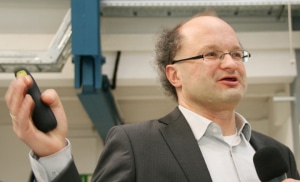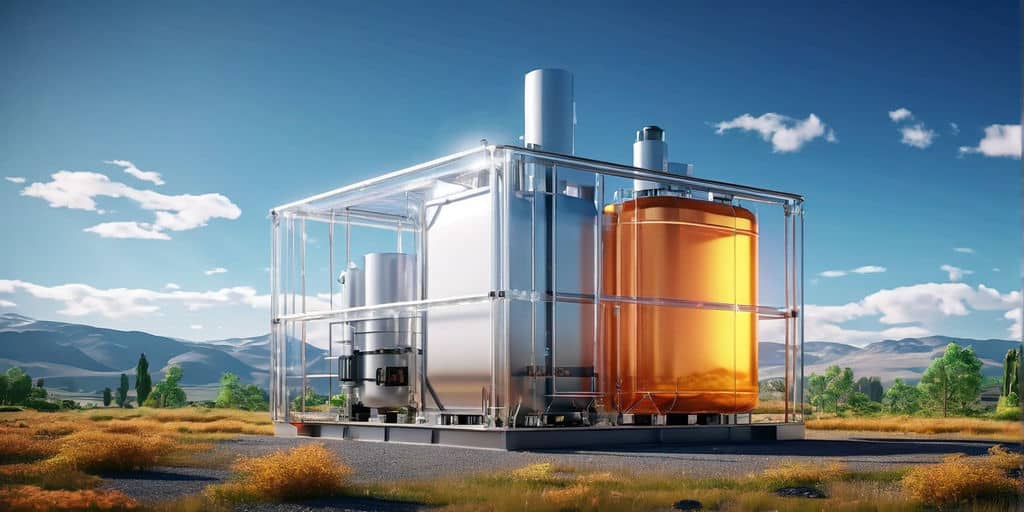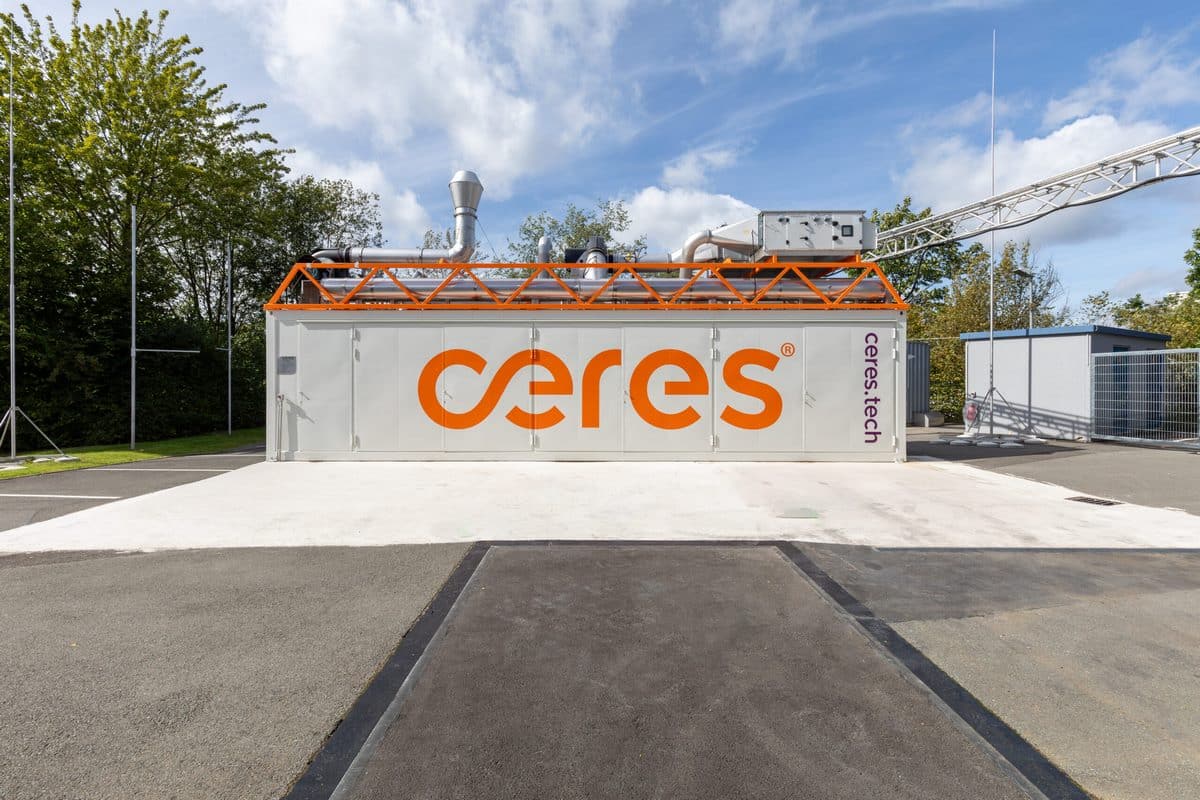Five years ago, some called carbazole the “wonder fuel” and “fuel source of the future,” although basic research hadn’t even been concluded yet. After intensive development, Hydrogenious Technologies has just presented a potential successor to the carbazole legacy: dibenzyl toluene. On Jan. 29, 2016, the company based in Erlangen, Germany, brought its first hydrogen storage unit based on this liquid organic hydrogen carrier (LOHC) into operation at the company’s headquarters. Around 150 people were present when Ilse Aigner, Bavaria‘s economy minister, inaugurated the system.
Development started with the doctoral thesis of Daniel Teichmann, now CEO of Hydrogenious. When he was looking for a dissertation advisor in 2010, it was professor Wolfgang Arlt who took on the job and – as the story continues – he has never regretted his decision. Together with professor Peter Wasserscheid, whose research was focused on ionic liquids, he discovered N-ethyl-carbazole (C14H13N, short: carbazole) as an energy carrier. When both professors presented their intermediate results at the beginning of this decade (see Arlt interview in HZwei issue from October 2011), it caught the attention of a lot of people, although research had still been limited to the laboratory.
Cornelius von der Heydt, head of sales at Hydrogenious Technologies, told H2-international: “The professors continued their research and tested a myriad number of different chemical compounds.” Finally, they found dibenzyl toluene. Von der Heydt said: “LOHC makes many market participants either think of carbazole or of toluene, which both show significant drawbacks compared to the material we’re using.”
For the 20-people team, it’s all about the heat transfer oil, which has been on the market for 40 years. The oil is similar to liquid diesel, but according to the chemical scientists, it‘s non-toxic, non-carcinogenic and won’t even go up in flames if a Bunsen burner is used – not even when it has been charged. However, the risk and safety warnings say it can be “fatal if swallowed and enters airways” (H 304) and “may cause long-lasting harmful effects to aquatic life” (H 413). But it costs only a few euro per liter.
There has long been a safety sheet for the non-charged substance. Certification for the charged one is ongoing, according to von der Heydt, and should be completed as soon as this summer.
Tab.: Storing 3 kilograms of hydrogen.
| GH2 (300 bar) | LOHC (ambient pressure) | |
| Weight | 250 kg | 50 kg |
| Volume | 150 L | 50 L |
“Hydrogen is a strategic resource to meet demand during supply shortages.”
Together with Matthias Beller (see below), Wasserscheid was awarded the Gottfried Wilhelm Leibniz Prize in 2006.
Pilot at Fraunhofer IAO
The Hydrogenious approach is based on the use of the organic chemical compound as a hydrogen transfer liquid. Wasserscheid, head of the Helmholtz Institute Erlangen (HI ERN), explained during the inauguration ceremony: “Nowadays, our energy industry relies on liquid fuels. LOHC is a medium that acts like a reusable bottle for hydrogen and is safer and better than the fuels that are available today.” To test the liquid, the Bavarian-based company set up a solar system on the roof of a neighboring building (98 kWpeak), in order to create hydrogen through sustainably generated power. This hydrogen is then stored in the “wonder fuel.” The electrolysis process uses the first generation of Siemens Silyzer systems, with a unit having been installed at the headquarters’ factory hall. Whereas the waste heat of the container is offered to the nearby swimming pool, the created hydrogen flows at 50 bar into the hydrogenation plant to be added to the dibenzyl toluene.
The so-called StorageBOX consists of two storage tanks, which were originally designed for milk processing and can hold up to 1,000 liters. One of the tanks contains the carrier, which absorbs the hydrogen in the reactor at 150 to 250 °C. One liter of LOHC can store 600 liters of GH2 (energy density: 1.9 MWh/m3). The catalyst is made of ruthenium. The almost-quiet intake process consumes up to 0.6 kilograms of hydrogen per hour. It is possible to repeat the reversible procedure around 1,000 times. And with the thermal oil showing a density similar to water (1,050 kg/Nm3), it can be stored indefinitely.
The crystal-clear liquid treated with hydrogen is then transported inside trailers to its destination. Even the company from northern Bavaria thinks it’s unlikely that hydrogen-driven cars will receive an LOHC tank in the future. But the liquid could make the supply of H2 filling stations a much more efficient business if instead of GH2 trailers – which mainly transport steel and only around 300 kilograms of hydrogen – suppliers would use LOHC-filled trucks. A 40-ton trailer could transport around 1,800 kilograms of hydrogen-treated LOHC and would even be allowed to go through all kinds of tunnels, whereas GH2 transports are not permitted in some of them.
The current test run supplies the Fraunhofer Institute for Industrial Engineering (IAO) in Stuttgart, Germany, which had a dehydrogenation system installed for demonstration purposes. The ReleaseBOX set up there reverses the previous exothermic process: The oil is pre-heated before passing through a 100 kW reactor, in which the gaseous hydrogen is separated at 300 °C from the heavy carrier medium. The use of platinum and palladium catalysts makes this a very simple separation process (boiling temperature: 390 °C). After purifying, the hydrogen generates electricity as part of a 30 kW fuel cell that charges electric cars.
Martin Johannes Schneider, head of Hydrogenious’s project development, said during the ceremony that “a few days ago, we placed our signatures under a large H2 logistics order placed by an American company.” The project is planned to be realized until January 2017. However, to be able to run further tests on the design, Schneider called for the addition of the technology to at least one of the 50 filling stations built with the help of a German H2 infrastructure program. So far, the administrator of that program, NOW, hasn’t commented on the idea.
Wealthy investor
Hydrogenious – which was presented with the Innovation Award of Bavaria in 2014 – receives the necessary financial backing from Anglo American Platinum (Amplats). The South African corporation invested USD 4 million in United Hydrogen Group (UHG) this January. As one of the world’s largest operators of platinum mines, Amplats has an inherent interest in the market roll-out of fuel cell cars, as their stacks require platinum as a catalyst – not unlike the three-way catalysts of conventional vehicles. In a media release to Creamer Media’s Mining Weekly Online, the marketing head of Amplats, Andrew Hinkly, said: “We ultimately want to reduce the cost of delivered hydrogen and increase access to hydrogen refueling stations. Our investment in UHG goes a long way to achieving both of these goals and supporting development of the FCEV market.”
The investment was made by Amplats‘s PGM Development Fund, which supports growing start-ups early on, in order to increase sales in platinum group metals (PGMs). Hydrogenious Technologies is one of the partners of this program and collaborates with UHG. The price for platinum suffered a considerable drop last year, which is why the subsidiary of Anglo American is trying to up demand again. The desire for a quick recovery also explains the platinum corporation’s investments in Ballard Power Systems and Altergy Systems.
The Hydrogenious design is one of four projects funded by the state of Bavaria in the framework of the Bavarian Hydrogen Center (BH2C). In her inaugural speech, state minister Aigner said she was “proud and very pleased.” She added: “Investing in and developing storage technologies locally is the right path to take. LOHC is one of the crucial technologies to consider.”
Areva does its own research
But research on the technology is not limited to Erlangen. The French Areva group as well as Swiss H2-Industries have set up their own research projects for LOHC. H2-Industries, which was founded by entrepreneur Michael Stusch in 2011, is currently looking to raise capital for their design. In fall of 2014, the company from Wollerau entered into a cooperation with professor Matthias Beller from the Rostock-based Leibnitz Institute for Catalysis (LIKAT), which has done some research on new catalysts for this type of application. Additionally, Stephan Möller – who manages balticFuelCells and whose second job is to provide energy consulting to end customers – is head of research at LIKAT laboratories. He also is the boss of the five H2-Industries employees sitting in an office in Teterow in northern Germany. Möller said: “Our new pilot plant in Teterow near Rostock is close to the University of Rostock, to LIKAT, to the Fraunhofer Institute for Manufacturing Technology (IPA) in Rostock, and to businesses required for a smooth realization of our ambitious plans.” He also explained to H2-international that H2-Industries put its faith in the same brand as Areva H2Gen – Marlotherm (brand name for dibenzyl toluene) – and that the company intends to go public to raise money. According to his statements, “there are a number of interested investors.”
The primary concern of Areva H2Gen, the German subsidiary of the French state-owned company specializing in nuclear technology, is still its electrolysis business. In mid-March 2016, it became a member of the DWV initiative Performing Energy. When talking to H2-international, Kerstin Gemmer-Berkbilek, the business’s LOHC representative, confirmed that the company was currently not trying to increase public awareness of the technology, but would be open to collaborations in the field of system integration.
Overall, the new competition is helping Hydrogenious’s case. As von der Heydt explained, LOHC has been taken much more seriously since a large industrial group like Areva announced that they were developing the technology. It has even prompted several representatives of big oil and gas companies to visit Erlangen. “Before that event,” he said, “everyone used to be a skeptic, since we do take away the business model of the traditional suppliers.” Now, he hopes that NOW will finally start listening too.
Cella develops solid storage
Cella Energy favors a somewhat different approach. The British business relies on pellets, which incorporate amino borane through a chemical process into nano-size polymer fibers. The fibers, which can absorb the hydride at temperatures of around 85 °C are being manufactured by electrospinning and pressed afterward. It is thought that their small size (few millimeters) makes them easy to pour, and they are said to be low on toxicity, non-aggressive and capable of storage at ambient temperatures in conventional tanks. Amino borane, however, is considered explosive. The technology was developed at the Rutherford Appleton Laboratory near Oxford, UK, where Cella Energy was created as a spin-off in 2011 for commercial purposes by the former founder and owner of Voller Energy, Stephen Voller (left Cella in 2013), as well as professor Stephen Bennington.





























0 Comments